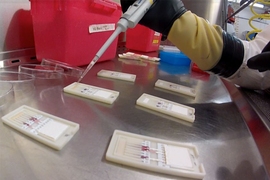Once a patient infected with the Ebola hemorrhagic virus starts showing symptoms, it can take several hours under the best conditions, and up to several days in remote areas, to get diagnostic results using conventional tests, such as identification of viral RNA. Further complicating the process, Ebola symptoms are very similar to those of other fevers, such as typhoid and malaria. Because time is of the essence in tracking Ebola and preventing its spread, researchers at MIT’s Institute for Medical Engineering and Science (IMES) are working on a new device that uses nanoparticles to capture the virus in patient blood samples and would offer much faster results. Lee Gehrke, the Hermann von Helmholtz Professor in IMES and a professor of microbiology and immunology at Harvard Medical School, described the project to MIT News.
Q. How does your experimental device detect Ebola and other diseases in patient blood samples?
A. One can detect Ebola, like any other hemorrhagic virus, in two ways: with lots of instruments or without lots of instruments. The media contains reports of a new Ebola test every week these days, and most of those are “black boxes” that have of lots moving parts and specialized chemical kits. Lots of these devices end up breaking down in the developing world.
We prefer a simple device, so we made paper with inkjet-printed molecules and specially tuned nanoparticles that bind to the virus. Then we use lasers to create fluidic pathways that control specific binding reactions of our Ebola-specific molecules. Our lab has traditionally been an RNA virus lab, so we are very interested in translating molecular-scale information into a macro-scale diagnostic that would improve health care.
Q. How could such a device help to monitor and contain disease outbreaks such as the current Ebola outbreak?
A. Surveillance and acute triage. Once health care professionals use our paper fluidic device to detect the virus, they can isolate that patient and initiate a treatment plan in minutes. Waiting an hour for lab results could mean infecting the rest of the waiting room. A fast diagnostic is more than convenient; it really affects the system of care.
Given large-scale usage, we can aggregate the diagnostic results into a crowd-sourced, real-time surveillance platform. The goal is to anticipate the spread of the epidemic in a distributed manner. We’re not going to stop Ebola by counting what happened yesterday; rather, we have to be able to detect what’s happening now so we can make predictions about the future. Our goal is for every first aid kit, every clinic, and every home in a village to have a cheap, rapid test where they can self-report results within 30 minutes. It’s giving all these great platforms for mobile health a verifiable ground-truth mechanism, just like a meteorologist relies on small weather stations across Massachusetts to make forecasts about tomorrow’s chance of snow.
Sierra Leone, Liberia, and Guinea are not going to develop their own Centers for Disease Control and Prevention overnight. This is one way to advance their epidemiological preparedness. The data can be analyzed in real time to provide early warning of virus infections, and to monitor the locations of virus infections.
Q. What stage of development is the device in now? What future steps are needed before it can be deployed?
A. The device detects Ebola and other viruses in the laboratory. We are in the middle of exciting engineering field studies and animal studies to evaluate device efficacy for deployment. We have a great team of collaborations around the world and around the country and everyone is moving as fast as possible to implement the technology with our clinical partners in West Africa. The next major step after validating the detection is selecting the right diffusion strategy — do we mass-manufacture a specific detection device? Or do we create local production protocols that would be adaptable in producing a variety of different types of devices dependent on need? Do we stamp out molds for the housing, or 3-D print locally? We have to be able to simulate field temperatures and humidity in the lab to make sure the devices are field-rugged. These are the types of questions we are discussing in the lab and in the field every week so that the technology helps people as soon as possible.










